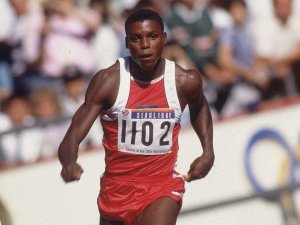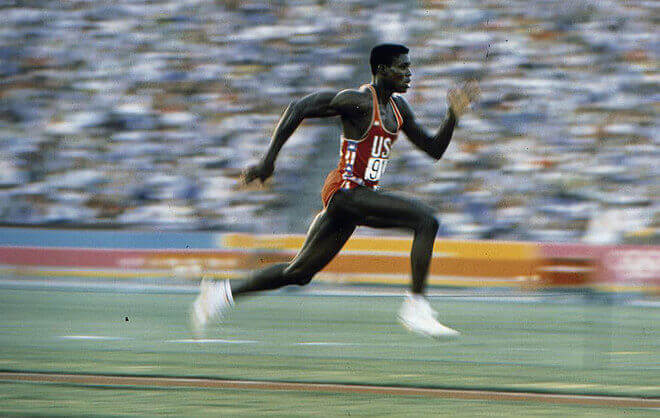Carl Lewis: Son of the Wind

The nickname for Carl Lewis is “Son of the Wind” and that description was never so applicable. This US athlete won gold medals in four consecutive Olympic Games and set various records. He was the fastest runner in the world. So, in this article, we’ll tell you about the life and career of the “Son of the Wind”.
Carl Lewis: the fastest sprinter
Born in Alabama in the United States in 1961, Carl started to compete in the long jump when he was only 15 years old. However, since he was also a very fast runner he also had good results with speed.
In 1980, at 19 years old, he was selected to be on the U.S. Olympic Team. As luck would have it, the Moscow Olympics were boycotted, which impeded his debut in the Russian capital. He had to wait four more years to begin his illustrious Olympic career in Los Angeles.
The gold medals won by Carl Lewis
At 23 years old he went to the Los Angeles Olympics on the West Coast of the US to fulfill his promise of winning four gold medals. He was on the podium of winners for short distance races (100 and 200 meters), long jump, and 100-meter relay.
The Los Angeles Olympics in 1984 was the first one for this man of 6 feet, 2 inches tall. Here he became a legend in running.

Images: Marca
The “Son of the Wind” was the first athlete to match the feats of Jesse Owens in Berlin in 1936. He hung four gold medals around his neck. What’s more, he beat the record of his compatriot by 9.86 seconds in the 100-meter race. Likewise, in the long jump, he held the record with 8.54 meters.
In the following Olympic Games in Soul in 1988, Carl was the favorite to win and he didn’t disappoint anyone. He won two gold medals and became the first runner to win the long jump in two consecutive games.
The controversies suddenly appeared. Due to a positive drug test, they found the Canadian, Ben Johnson guilty of doping, so he was disqualified in the 100-meter relay. This information was discovered hours after the race. For some, it was the “race of shame”, and this increased the competition among athletes even more.
It’s also worth mentioning that Carl won the silver medal for the 200-meter race.

Image: cubadebate.cu
The last years of his career
Carl was 31 years old when he decided to compete in the Barcelona Olympics in 1992. In contrast to what people thought, he was still the “Son of the Wind”. He won a gold medal in the long jump (for the third consecutive time) and another in the 100-meter relay.
His final competition was in the 1996 Olympics in Atlanta, where he didn’t classify due to lack of speed and wasn’t on the relay team. Nevertheless, he won fourth place for the long jump.
This was when he won his last and ninth Olympic gold medal. If we count the silver in 1992, Carl Lewis won a total of ten awards in the Olympics that he participated in.
Up until now, the only athletes who have won gold in four Olympic Games have been Al Oerter, a discus thrower, Paul Elvstrom in yachting, and Michael Phelps the swimmer.
After the medals and the fame
Carl Lewis retired at 35 years of age after Atlanta in 1996. In fact, he’s known to be the best male athlete of the 20th century by the International Federation of Athletics Federation. Not only did Carl win ten Olympic gold medals, but he also won ten world medals, eight of them gold. Even more, he broke ten world records.
After leaving the sports arena, he became an actor and a vegan in 1990. He wrote in his book, that since changing his lifestyle, he performs even better in sports.
Carl Lewis is in the World Hall of Fame for Athletes, not only because of his twelve Olympic gold medals but also for his records and other awards. Beyond the “race of shame”, nothing can darken the history of this athlete who represented his sport very well.
The nickname for Carl Lewis is “Son of the Wind” and that description was never so applicable. This US athlete won gold medals in four consecutive Olympic Games and set various records. He was the fastest runner in the world. So, in this article, we’ll tell you about the life and career of the “Son of the Wind”.
Carl Lewis: the fastest sprinter
Born in Alabama in the United States in 1961, Carl started to compete in the long jump when he was only 15 years old. However, since he was also a very fast runner he also had good results with speed.
In 1980, at 19 years old, he was selected to be on the U.S. Olympic Team. As luck would have it, the Moscow Olympics were boycotted, which impeded his debut in the Russian capital. He had to wait four more years to begin his illustrious Olympic career in Los Angeles.
The gold medals won by Carl Lewis
At 23 years old he went to the Los Angeles Olympics on the West Coast of the US to fulfill his promise of winning four gold medals. He was on the podium of winners for short distance races (100 and 200 meters), long jump, and 100-meter relay.
The Los Angeles Olympics in 1984 was the first one for this man of 6 feet, 2 inches tall. Here he became a legend in running.

Images: Marca
The “Son of the Wind” was the first athlete to match the feats of Jesse Owens in Berlin in 1936. He hung four gold medals around his neck. What’s more, he beat the record of his compatriot by 9.86 seconds in the 100-meter race. Likewise, in the long jump, he held the record with 8.54 meters.
In the following Olympic Games in Soul in 1988, Carl was the favorite to win and he didn’t disappoint anyone. He won two gold medals and became the first runner to win the long jump in two consecutive games.
The controversies suddenly appeared. Due to a positive drug test, they found the Canadian, Ben Johnson guilty of doping, so he was disqualified in the 100-meter relay. This information was discovered hours after the race. For some, it was the “race of shame”, and this increased the competition among athletes even more.
It’s also worth mentioning that Carl won the silver medal for the 200-meter race.

Image: cubadebate.cu
The last years of his career
Carl was 31 years old when he decided to compete in the Barcelona Olympics in 1992. In contrast to what people thought, he was still the “Son of the Wind”. He won a gold medal in the long jump (for the third consecutive time) and another in the 100-meter relay.
His final competition was in the 1996 Olympics in Atlanta, where he didn’t classify due to lack of speed and wasn’t on the relay team. Nevertheless, he won fourth place for the long jump.
This was when he won his last and ninth Olympic gold medal. If we count the silver in 1992, Carl Lewis won a total of ten awards in the Olympics that he participated in.
Up until now, the only athletes who have won gold in four Olympic Games have been Al Oerter, a discus thrower, Paul Elvstrom in yachting, and Michael Phelps the swimmer.
After the medals and the fame
Carl Lewis retired at 35 years of age after Atlanta in 1996. In fact, he’s known to be the best male athlete of the 20th century by the International Federation of Athletics Federation. Not only did Carl win ten Olympic gold medals, but he also won ten world medals, eight of them gold. Even more, he broke ten world records.
After leaving the sports arena, he became an actor and a vegan in 1990. He wrote in his book, that since changing his lifestyle, he performs even better in sports.
Carl Lewis is in the World Hall of Fame for Athletes, not only because of his twelve Olympic gold medals but also for his records and other awards. Beyond the “race of shame”, nothing can darken the history of this athlete who represented his sport very well.
All cited sources were thoroughly reviewed by our team to ensure their quality, reliability, currency, and validity. The bibliography of this article was considered reliable and of academic or scientific accuracy.
- Asociación Española de Estadísticos de Atletismo. Carl Lewis, mejor atleta mundial del siglo XX. http://www.rfea.es/aeea/archivos/Carl_Lewis_el_mejor_atleta_sigloXX.pdf
- Guttmann, A. (2010). The Cold War and the Olympics. International Journal. https://doi.org/10.2307/40202563
This text is provided for informational purposes only and does not replace consultation with a professional. If in doubt, consult your specialist.








